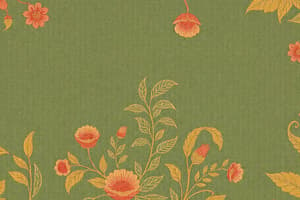Podcast
Questions and Answers
What affects the luster of a fiber?
What affects the luster of a fiber?
- Type of spinning process used
- Surface smoothness and chemical orientation (correct)
- Fiber color and weight
- Moisture absorption levels
Which fiber type is likely to exhibit a shiny luster?
Which fiber type is likely to exhibit a shiny luster?
- Cotton
- Bast fibers
- Silk (correct)
- Wool
What is the primary purpose of conditioning textiles before testing?
What is the primary purpose of conditioning textiles before testing?
- To enhance color vibrancy
- To reduce moisture absorption
- To ensure consistent measurements (correct)
- To increase fiber strength
What is the difference between absorption and adsorption in textiles?
What is the difference between absorption and adsorption in textiles?
Which property is primarily associated with the stretch or extension of a fiber?
Which property is primarily associated with the stretch or extension of a fiber?
How does the presence of amorphous regions in a fiber affect its luster?
How does the presence of amorphous regions in a fiber affect its luster?
What is wicking in the context of fiber properties?
What is wicking in the context of fiber properties?
What term describes the attraction and retention of moisture within the pores of a fiber?
What term describes the attraction and retention of moisture within the pores of a fiber?
What is the formula for calculating percent elongation of a material?
What is the formula for calculating percent elongation of a material?
Which property indicates the maximum temperature a fiber can withstand without damage?
Which property indicates the maximum temperature a fiber can withstand without damage?
What characteristic of protein fibers typically occurs when they are exposed to heat?
What characteristic of protein fibers typically occurs when they are exposed to heat?
How does moisture absorption affect the electrical conductivity of fibers?
How does moisture absorption affect the electrical conductivity of fibers?
What two factors primarily influence abrasion resistance in fibers or fabrics?
What two factors primarily influence abrasion resistance in fibers or fabrics?
Which type of fibers are generally good electrical conductors due to their hydrophilic nature?
Which type of fibers are generally good electrical conductors due to their hydrophilic nature?
What is the burning characteristic of synthetic fibers when exposed to heat?
What is the burning characteristic of synthetic fibers when exposed to heat?
What is the significance of the glass transition temperature (Tg) in fibers?
What is the significance of the glass transition temperature (Tg) in fibers?
Flashcards
Percent Elongation
Percent Elongation
The ratio of a material's extension to its original length, expressed as a percentage.
Resilience
Resilience
A material's ability to spring back to its original shape after being deformed.
Thermal Properties of Fibers
Thermal Properties of Fibers
How a fiber reacts to heat, including melting point, glass transition temperature, flammability, and safe ironing temperature.
Melting Point (Tm)
Melting Point (Tm)
Signup and view all the flashcards
Glass Transition Temperature (Tg)
Glass Transition Temperature (Tg)
Signup and view all the flashcards
Flammability
Flammability
Signup and view all the flashcards
Electrical Conductivity
Electrical Conductivity
Signup and view all the flashcards
Abrasion Resistance
Abrasion Resistance
Signup and view all the flashcards
Luster
Luster
Signup and view all the flashcards
Moisture Absorption (Fiber)
Moisture Absorption (Fiber)
Signup and view all the flashcards
Wicking
Wicking
Signup and view all the flashcards
Elongation
Elongation
Signup and view all the flashcards
Recovery
Recovery
Signup and view all the flashcards
Color
Color
Signup and view all the flashcards
Thermal property
Thermal property
Signup and view all the flashcards
Secondary fibre properties
Secondary fibre properties
Signup and view all the flashcards
Study Notes
Fiber Properties
-
Luster: The way a fiber reflects light from its surface depends on the smoothness or irregularity of its surface. Smooth surfaces reflect more light. Chemical orientation (amorphous vs. crystalline regions) influences luster. Crystalline regions reflect more light while amorphous regions reflect less. Bright/shiny fibers (silk, nylon) have more crystalline regions, while dull/matte fibers (cotton, wool) have more amorphous regions.
-
Color: Color varies by fiber type (wool, cotton, bast, man-made fibers). It affects the appearance of the final product.
-
Moisture Absorption: Textiles are conditioned in a standard atmosphere before testing. A consistent 65 ± 2% relative humidity is used in tests for reliable comparisons between laboratories. Moisture absorption includes adsorption (attracting and retaining moisture in the fiber's pores), and wicking (the ability of the fiber to move moisture quickly along its surface).
-
Elongation and Recovery: Elongation is the amount of stretch or extension a fiber, yarn, or fabric can accept. Percent elongation is the ratio of the extension to the original length ( ((extended length - original length)/original length) * 100).
-
Resiliency (or Wrinkle Recovery): The ability of a fiber to return to its original shape after bending or folding. Good resiliency is important in apparel and fabrics like polyester. Compressive resiliency (or loft) is the ability of a fiber to return to its original thickness after being crushed.
-
Thermal Properties: These properties are exhibited when a fiber is exposed to heat. The thermal properties of different fibers include melting points (Tm), the glass transition temperature (Tg) and the ability to withstand different ironing temperatures without damage. Different types of fibers react to heat/ fire in varied ways (protein, plant, synthetic).
-
Electrical Conductivity: The ability of a fiber to conduct electricity. Natural fibers are generally conductors (hydrophilic) and synthetics are generally poor conductors (hydrophobic). Metal/carbon fibers are good conductors. Conductivity increases with higher moisture absorption; this characteristic is important for static control.
-
Abrasion Resistance: The ability of a fiber/yarn/fabric to withstand surface wear, rubbing, or chafing during use. Yarn and fabric construction, fiber properties, and finishing techniques can influence abrasion resistance. Testing methods include flex abrasion and flat abrasion.
Studying That Suits You
Use AI to generate personalized quizzes and flashcards to suit your learning preferences.



